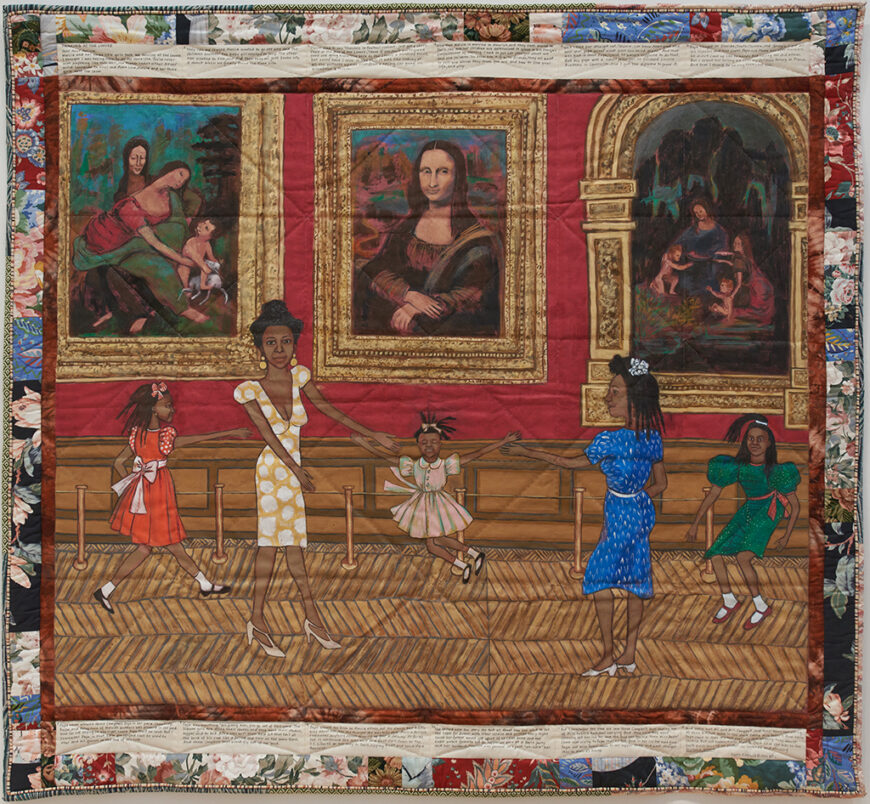Gee’s Bend quilts challenge notions of what is—and what is not—modern art.
Rita Mae Pettway, Housetop (fractured medallion variation), 1977, corduroy, 80 x 76 inches (Virginia Museum of Fine Art). Speakers: Valerie Cassell Oliver, Curator of Modern and Contemporary Art, Virginia Museum of Fine Arts, and Beth Harris
[0:00] [music]
Dr. Beth Harris: [0:04] We’re in the Virginia Museum of Fine Arts, looking at a quilt by Rita Mae Pettway called “Housetop.” This is one of many fabulously beautiful quilts made by the quilters in Alabama, in Gee’s Bend.
Valerie Cassell Oliver: [0:21] One of the things I really felt very compelled by was the creative brilliance of these women who have lived and worked in Gee’s Bend for generations. And Pettway is a huge name in Gee’s Bend. It is literally a Pettway dynasty that have over centuries created such a beautiful wealth of quilts.
[0:42] What I love about this piece and what I love about the grouping that we were able to bring into the museum is that they were all created roughly in the 1970s. What was very interesting about that is in early 1970s, they entered into a cooperative called the Freedom Quilting Bee Cooperative, which had a contract with Sears, Roebuck, and Company.
[1:03] They were charged with creating bedding in corduroy, and oftentimes they were able to bring home scraps and leftover materials. And so there’s something about the use of that corduroy that brings such a deep, rich hue to bear. She’s using these strips, this cast-off material, these scraps, to create something quite phenomenal.
[1:27] It is that richness that we see, and because this is a fractured medallion, the symmetry’s been broken up in terms of the color. The alternating colors gives it a certain kind of rhythm. But it also, to me, speaks of thought processes, particularly among African American vernacular culture, that evil travels in straight lines. You disrupt that path, you disrupt that through disorientation.
Dr. Harris: [1:56] I think that this is a very important idea that we’re looking at household items made to keep people warm.
Valerie: [2:05] These quilts were also used for the walls. They were used for the floor. They were used to protect from the elements. In this, you also see that there’s this added spiritual layer. They’re almost seen as talismans when they’re put on the body, that they protect from evil.
Dr. Harris: [2:23] We’re talking about traditions that go back to the early 19th century in this particular place.
Valerie: [2:30] Generations of enslaved African Americans, and what makes Gee’s Bend so important is we know that that was a very isolated community. We know that these individuals, the Pettways, they have taken their surname from the Pettway plantation.
[2:47] So we know they were in a part of Alabama cut off because of a river and because of that, we do see this enclave where an aesthetic, however fragmented from West Africa, is fused with other aesthetics coming from First Nations or from European American culture, and how they manifest and are preserved and perpetuated from one generation to the next.
Dr. Harris: [3:10] Some of the lines aren’t straight where the pieces are being put together. There is this feeling to me of the people who sat and quilted this, and the irregularity to me is part of its beauty.
Valerie: [3:22] Absolutely. One of the things that I’ve tried to explore is how spirituality is also somehow embedded, that there is a desire to take the expressive and the intangible and embed them in the aesthetic. It is something about imbuing those types of things that allows it to pulsate.
[3:43] In the most simplistic thing you find great complexity. And I think that is part of that spiritual leaning that I find so fantastical about this work. Here were individuals who did not have the academic training, but who still knew color theory, who still knew how to create movement.
Dr. Harris: [4:02] And when they talk about their work, talk about that kind of improvising.
Valerie: [4:06] There is an understanding of colors being loud or being quiet, or rushing toward you, or receding and being faint. If jazz is the original American musical art form, what would be the equivalent to that?
Dr. Harris: [4:24] Quilting?
Valerie: [4:24] Quilting.
[4:25] [music]




